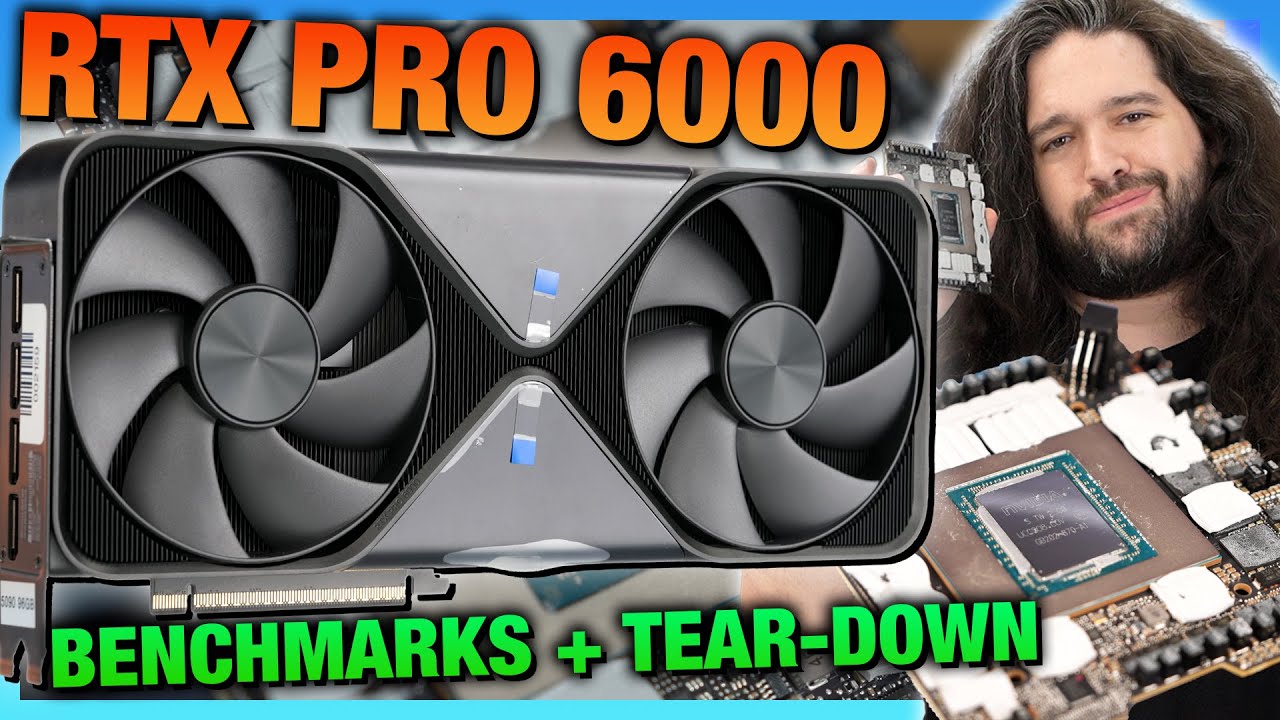The NVIDIA RTX Pro 6000 Blackwell is a high-end professional GPU with exceptional hardware density and 96 GB of GDDR7 memory, excelling in AI and large language model workloads while offering moderate gaming performance gains over the RTX 5090. Its teardown reveals a design focused on reliability and longevity, with effective cooling and impressive VRAM capacity that drives substantial performance improvements in professional applications despite a higher thermal profile and cost.
The video begins with the teardown and independent benchmarking of the NVIDIA RTX Pro 6000 Blackwell GPU, a high-end professional graphics card purchased for $8,000. The presenter highlights the challenges with NVIDIA’s reluctance to provide fair, independent reviews, prompting them to acquire the hardware themselves. The RTX Pro 6000 is praised for its impressive hardware density, featuring a nearly full Blackwell die with 24,064 CUDA cores and a massive 96 GB of GDDR7 memory, significantly more than the consumer RTX 5090. The card is designed primarily for professional workloads, especially AI and machine learning, rather than gaming, although gaming benchmarks are included to test the system’s CPU and GPU scaling.
The teardown reveals a highly dense PCB with 32 memory modules and a unique cooling design that notably lacks liquid metal thermal interface material, unlike the RTX 5090. This omission is speculated to be a deliberate choice for reliability and longevity in professional environments, where hardware stability is paramount. The cooler design is praised for its mechanical excellence and effective airflow management, despite running hotter than the 5090 by about 10 degrees Celsius during thermal testing. The VRAM temperatures remain similar between the two cards, but the Pro 6000’s fan operates at a slightly higher RPM, resulting in comparable acoustic performance.
Gaming benchmarks show the RTX Pro 6000 outperforming the RTX 5090 by about 5-14% across various titles and resolutions, with the performance gap widening at higher resolutions. However, the presenter emphasizes that gaming is not the intended use case for this card, and the price-to-performance ratio in gaming scenarios is not favorable. The benchmarks also highlight the continued strong performance of the AMD Ryzen 9800 X3D CPU used in the test system, showing good scaling potential with these high-end GPUs. Ray tracing and rasterization tests confirm consistent performance gains for the Pro 6000, although the improvements are modest relative to the significant price difference.
The video then shifts focus to experimental AI and large language model (LLM) benchmarks, where the RTX Pro 6000 truly shines due to its large VRAM capacity. Tests with various models demonstrate substantial performance advantages over the RTX 5090 and 4090, especially with larger models that exceed the memory limits of consumer cards. The Pro 6000 achieves up to a 900%+ improvement in token processing speeds on the largest tested models, illustrating the critical importance of VRAM capacity in professional AI workloads. The presenter notes the experimental nature of these benchmarks and invites suggestions for future testing.
In conclusion, the RTX Pro 6000 Blackwell is a remarkable piece of engineering tailored for professional and AI workloads, offering massive memory capacity and solid performance gains over consumer GPUs. While it is not designed or cost-effective for gaming, it demonstrates the potential for future GPU scaling on the test bench platform. The teardown and thermal analysis provide valuable insight into NVIDIA’s design choices prioritizing reliability over peak cooling efficiency. The presenter also hints at potential future overclocking experiments and further exploration of the card’s capabilities, encouraging viewers to subscribe and support the channel for more in-depth hardware reviews.
